Collapsible plate heat exchangers
Plate heat exchangers offered by NGO are an economical solution due to their high efficiency, small dimensions and ease of maintenance.

Collapsible plate heat exchangers have the effect of self-descaling, which is provided by high flow turbulence.
The mounting of the seals of the plates of the collapsible plate heat exchangers is made using LOC-IN and ECO-LOC technologies. These technologies can significantly improve the fixation of seals in the plates, and therefore ensure complete tightness of the heat exchanger. Stainless steel is used for the manufacture of plates.
Collapsible plate heat exchangers are supplied with a set length of the amax plate package. Due to the natural decrease in the thickness of the seals during operation, additional compression of the plate package to the size of fm in is possible instead of replacing the seals.
Conditions of application of collapsible plate heat exchangers: :
- working pressure up to 25 atm;
- operating temperature from -25 to +180°C
Working media: liquid, steam, liquid with impurities, refrigerants.
The service life of the collapsible plate heat exchanger is 15 years – provided that the requirements of operation, proper installation and timely maintenance are met.
Each collapsible plate heat exchanger is calculated individually according to customer requirements. To perform the calculation, it is necessary to fill out a questionnaire, specifying in it the main operating parameters: power, temperature, pressure, etc.
VT Series
The number of plates in the heat exchanger, their layout, material, shape and size are determined by the specific task of heat exchange. Depending on the application, the heat exchanger plates can be made of chromium-nickel, chromium-nickel-molybdenum stainless steels, titanium and other materials.
The VT series plates are represented by 23 types. They have different sizes, corrugation profiles and are characterized by different heat transfer coefficients and pressure losses. Heat transfer surfaces from 0.05 to 2.5 m2 per plate, up to 2000 m2 per package of plates. The performance of heat exchangers can reach 3600 cubic m3/h.
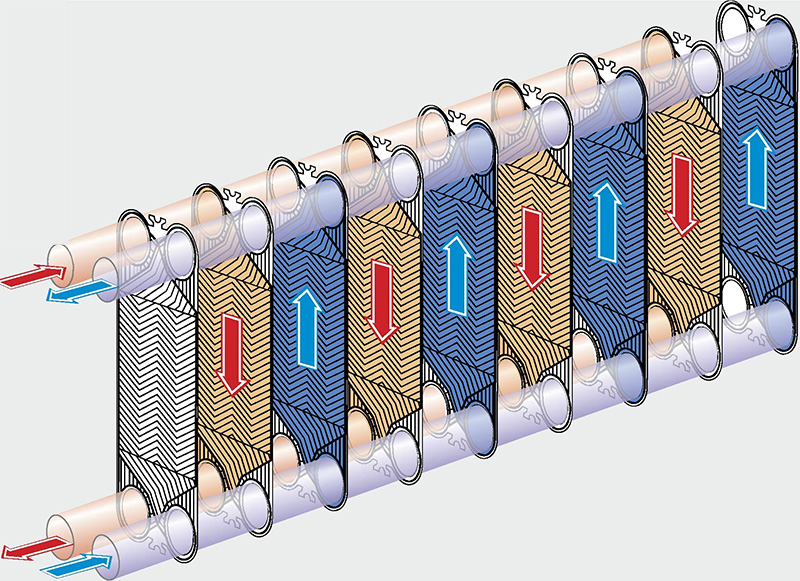
Plate manufacturing material:
• stainless steel;
• titan;
• hastelloy;
Plate sealing material:
• nitrile rubber (NBR);
(NBR);
• ethylene propylene rubber (EPDM);
• viton.
Conditions of use of collapsible plate heat exchangers of the VT series:
- operating pressure up to 25 atm;
- operating temperature from -25 0C to +200 0C;
Working media: liquid, steam.
NT Series
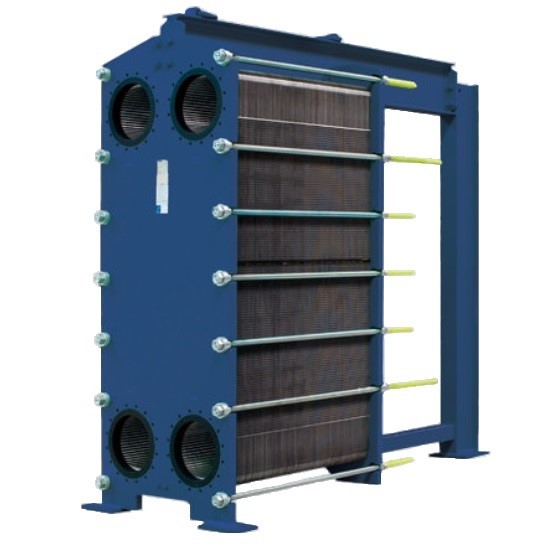
The design of the NT series heat exchanger ensures flow distribution over the entire width of the plate, increasing the efficiency of heat transfer with fewer plates.
Improved technical characteristics, a wider range of applications, ease of maintenance at a minimum cost — all these are plate heat exchangers of the NT series.
The optimized configuration of the profile and corrugations of the plates allows to achieve greater heat transfer power with a smaller heat transfer area due to a more uniform distribution of flows over the entire width of the plate. Naturally, this significantly reduces the cost of new NT series heat exchangers.
The configuration of the NT series heat exchanger plates raises the efficiency of heat transfer to a new level.
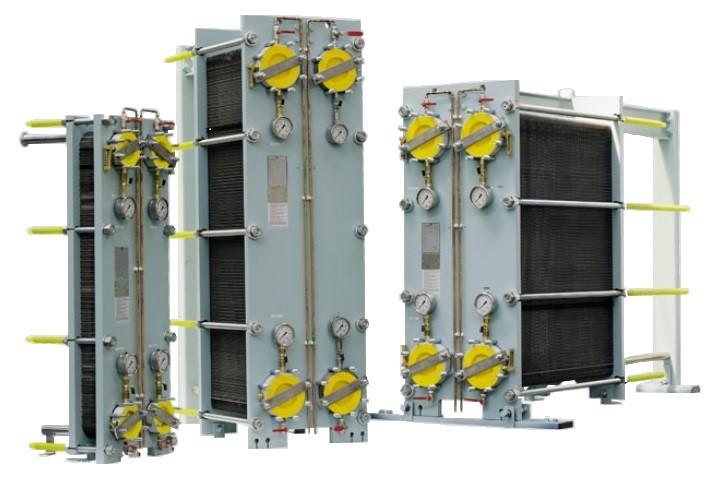
Pressed grooves for seals are located along the perimeter of the plate. Seals are designed to separate channels from each other, prevent leaks and mixing media. They also determine the flow direction inside the plate heat exchanger.
Seals are made of nitrile rubber (NBR), ethylene propylene rubber (EPDM), Viton material. The choice of material depends mainly on the media used, as well as their operating temperatures and pressures. Conventional plates allow most media to flow directly from one port to another, reducing the flow on the far side of the plate. This means that the heat exchange area is not fully used, which means that more plates are needed to achieve the specified parameters.
The design of the NT series heat exchanger ensures flow distribution over the entire width of the plate, increasing the efficiency of heat transfer with fewer plates.
NX Series
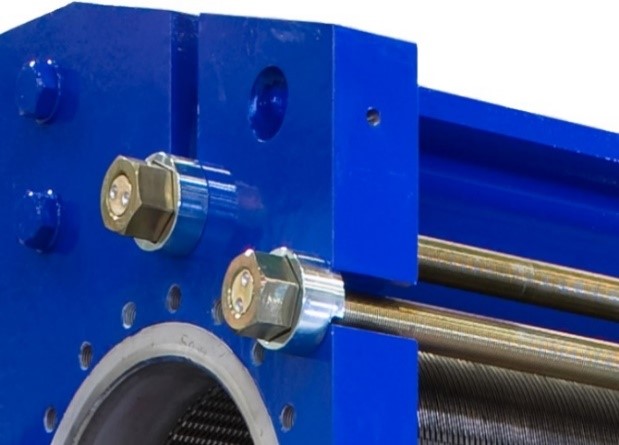
Collapsible plate heat exchangers of the NX series are a new step in the heat exchange of clean media with low viscosity in processes with high operating pressure. When using plates of the NX series, the temperature difference between the heat carriers can reach 1 ° C with fewer plates in the package and a single-pass design of the device.
Advantages
Increase efficiency and reduce costs for you.
In the NX series heat exchangers, a smaller heat exchange surface is required to achieve the desired power, which will significantly reduce your costs without compromising performance.
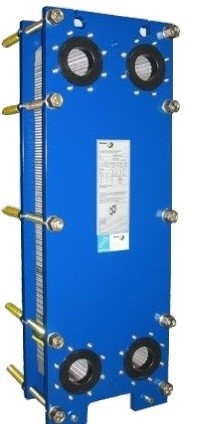
High operating pressures
The design operating pressure for the new NX series heat exchangers is 29 bar, which significantly increases the range of their application in various technological processes.
Collapsible plate heat exchangers of the N series are distinguished by an improved frame design with a wide selection of materials and plate configurations, and connection sizes. The N-series plates are a technologically perfect solution to heat transfer problems. The features of the plates ensure efficient heat treatment of any media, including products with high viscosity and a tendency to scale formation.
Brazed plate heat exchangers
GBS, GBE series. .
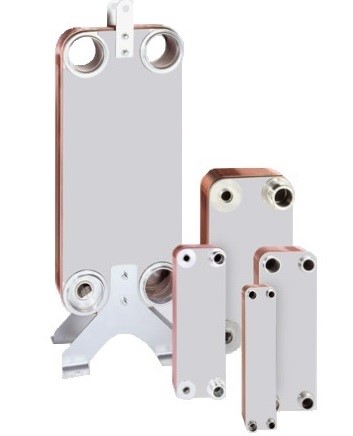
Heat exchangers of the GBS, GBE series are high–quality heat exchangers with copper solder. The GBS series is a standard series of brazed heat exchangers (used at pressures up to 30 bar and temperatures up to 200 °C, the GBE series is an economical series (for pressures up to 16 bar and temperatures up to 150 °C.
The plates are stamped and bagged on an automated press line, and the soldering process is controlled by a computer. All equipment is subjected to pneumatic hydraulic tests before shipment.
Working media:
- refrigerant- liquid;
- liquid-liquid;
- air is a liquid for working under pressure.
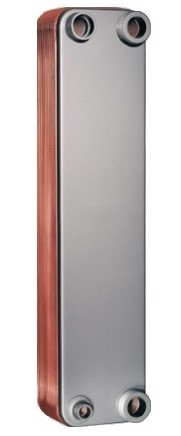
Applications: GVS systems, underfloor heating systems, snow melting stations, evaporators of refrigerating machines, heaters and condensers, oil coolers.
In plate heat exchangers, adjacent plates form channels in which hot and cold heat carriers move alternately through a package of plates.
Due to the low cost, compact size, excellent efficiency and ease of maintenance, these heat exchangers are an advantageous solution for use in housing and communal services and various industries.
Application conditions:- operating pressure up to 25 atm;
- operating temperature from -25 to +180°C;
- working media liquid, steam, liquid with impurities, refrigerants
Brazed plate heat exchangers
Heat exchangers of this type are used in situations where for some reason it is impossible to install collapsible plate heat exchangers. Compared to collapsible heat exchangers, plate heat exchangers can operate in a wider range of pressures and temperatures. The fact that almost the entire surface of the plates is involved in the heat transfer process ensures compact dimensions and an attractive price.
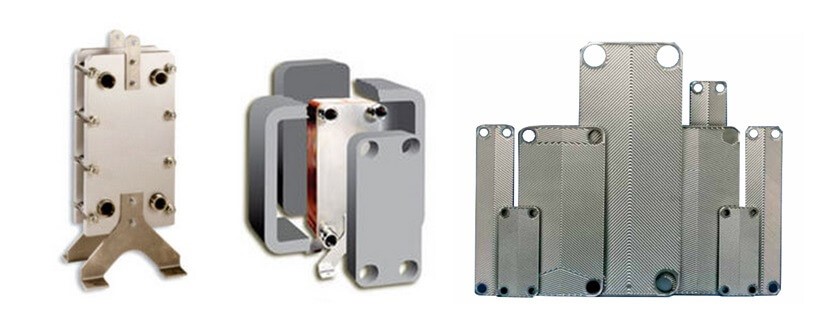
Advantages:
- High reliability due to design features and advanced manufacturing technologies;
- High efficiency;
- Wide operating temperature range;
- High working pressure;
- High corrosion resistance;
- Compact and light weight;
- Small internal volume;
- Wide range of capacities and overall dimensions;
- Availability of various connection options and flow schemes, including two-way;
- A large selection of accessories.
GNS (NP) Series
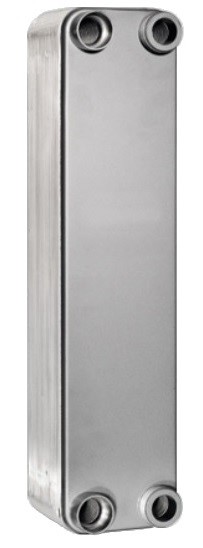
Heat exchangers of the GNS (NP) series are nickel—brazed heat exchangers. Their design provides countercurrents with appropriate turbulence even at low flow temperatures.
The NP series has the qualities of heat exchangers with copper solder and is optimally suited for:
• liquid refrigerants;
• systems with ammonia;
• especially pure water;
• deionized water and media aggressive to copper.
The GNS series heat exchangers have all the advantages of brazed plate heat exchangers, but they have significantly higher corrosion resistance, such as ammonia, deionized water, sulfides and sulfates. Not all nickel solders are the same: only about 75% are made of pure nickel, the remaining 25% is the company’s know—how, which provides benefits for the customer.
Proven technical options such as Safety ChamberTM, Delta InjectionTM and Full Flow SystemTM are available for the GNS series heat exchangers. Due to this, the GNS series products can be used for a wide range of applications with temperatures up to 200°C/392°F and a pressure of 16 bar/232 lb/sq. inch.
GBH Series
GBH series heat exchangers are new copper brazed heat exchangers designed to operate with a pressure of up to 45 bar and having a wide range of flow schemes. The new GBH series is designed to work with the non-destructive ozone layer refrigerant R41Od and has optimized plate corrugation and improved connections.
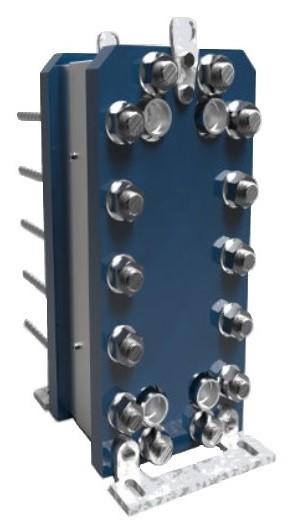
Technical specifications
Plate material: stainless steel AISI 316/1.4401
Solder: Copper
Operating pressure and temperature: up to 45 bar at 150°C and 40 bar at 200°C
Application areas:
• системы ГВС;
• air conditioning systems;
• heat transfer in technological schemes;
• condensation of various refrigerants;
• technological processes at high pressures;
• evaporators of refrigerating machines;
• cooling evaporators;
• heaters and condensers.
GG Series

A powerful and reliable heat exchanger is the most important element of the heating system, ensuring that drinking water remains safe for health.
Heat exchangers of the GG series are an effective solution to the problem of heat exchange in the process of heating drinking water. They organically combine the numerous advantages of collapsible and brazed heat exchangers. Special seals, the use of stainless steel plates and the revolutionary design of the frame provide excellent results, low costs and hygiene.
The heat exchangers of the GG series comply with European and international standards, and their operation is reliable.
Advantages:
- the possibility of use when heating drinking water;
- corrosion resistance;
- profitability;
- long service life;
- hygiene;
- light weight;
- compactness.
Welded shell-plate heat exchangers
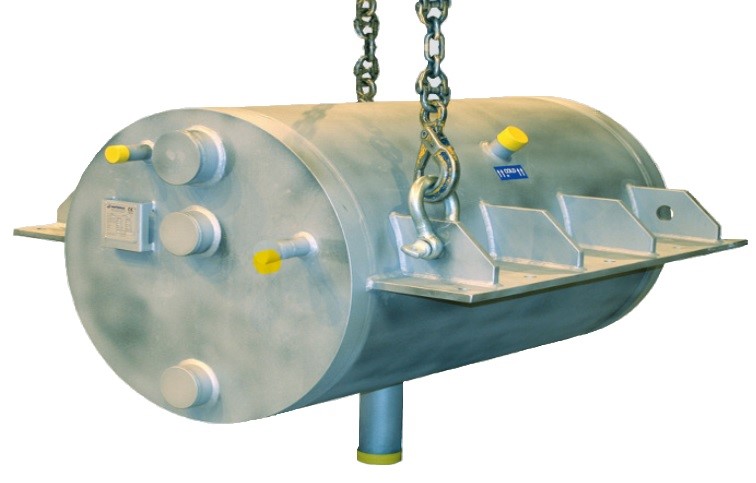
Welded shell-and-plate heat exchangers combine all the advantages of plastic and shell-and-tube heat exchangers and are reliable, compact devices without seals. They are characterized by a high heat transfer coefficient and good resistance to high temperatures (up to 900 °) and pressure (up to 140bar).
The structure can be completely welded or, in some cases, with a single-pass option on the side of the plates for inspection and cleaning. In addition, a compact design is possible – in this case, the inlet and outlet pipes of the casing are located on the front cover of the heat exchanger.
The flow movement can be realized according to the principle of counterflow, forward flow and cross flow. If necessary (small temperature differences between heat carriers), all-welded heat exchangers can be manufactured in a multi-pass design, both on the side of the plates and on the side of the casing. On the side of the casing, the passages are formed using special separating and guiding elements.
The main variants of execution:
— cascade systems;
— capacitors;
— OH-evaporators;
— evaporator/separator;
— the evaporator of the flooded type;
Media used:
— liquid/liquid;
— gas/liquid;
— gas/gas.
Thermal points
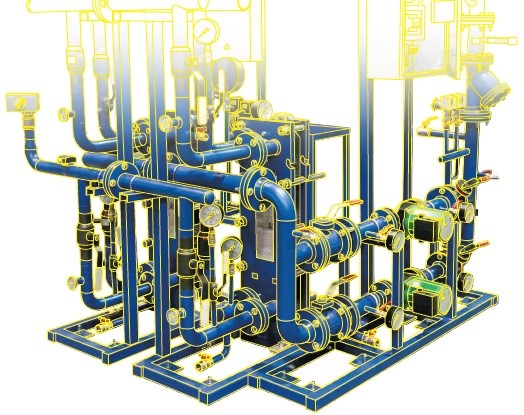
The NGO company supplies heating points of various capacities: from apartment ITPS for 10-15 kW to block-modular TSCs with a capacity of up to 65 MW.
Thermal points are designed to connect heating systems, hot water supply and ventilation of new and reconstructed industrial and residential facilities, individual offices, cottages, garages and other premises and buildings, as well as for various technological systems of industrial enterprises. NGO LLC offers a range of services for the design and manufacture of heating units, as well as the departure of specialists for installation supervision and commissioning at the Customer’s facility. We offer our customers a ready-made design solution certified as a single product.
Thermal points for various working environments
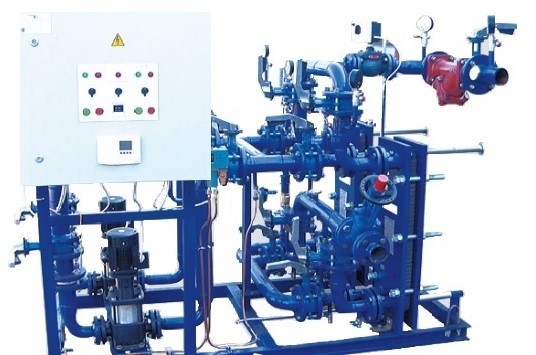
Various working media can be used as a heat carrier in thermal points.
Steam-water heating point
Steam is used as a heating medium, water is used as a heated medium. In the production of steam BTP, standard technical solutions for steam condensate systems are used. Due to the high operating parameters of the medium, special pipeline fittings, complex automation systems and control of output parameters are used. Increased safety requirements are imposed on such thermal points.
Water-water heat point
Water is used as a heating and heated medium. In the production of this type of BTP, standard technical solutions and automation schemes are used.
Each heat point undergoes multilevel quality control at all stages of manufacturing.
Heat point with non-standard environments
As a heating and/or heated medium, non-standard media are used – oils, acids, oil, fuel oil, glycol-containing solutions, etc. These are the most technically complex thermal points that require individual technical solutions. They use highly specialized fittings, complex automation systems with precision maintenance of adjustable parameters. Such thermal points are subject to increased requirements for the safety and quality of equipment (corrosion resistance, explosion safety, etc.).
